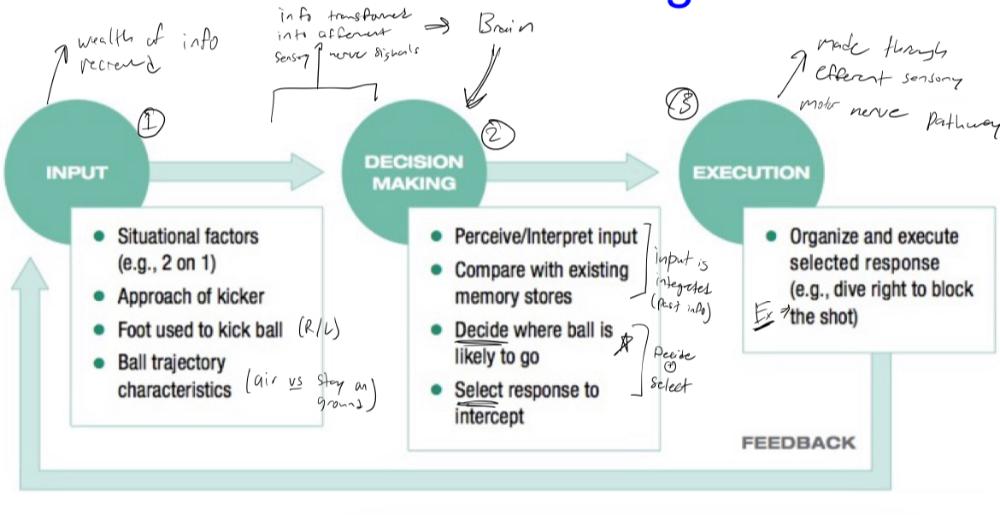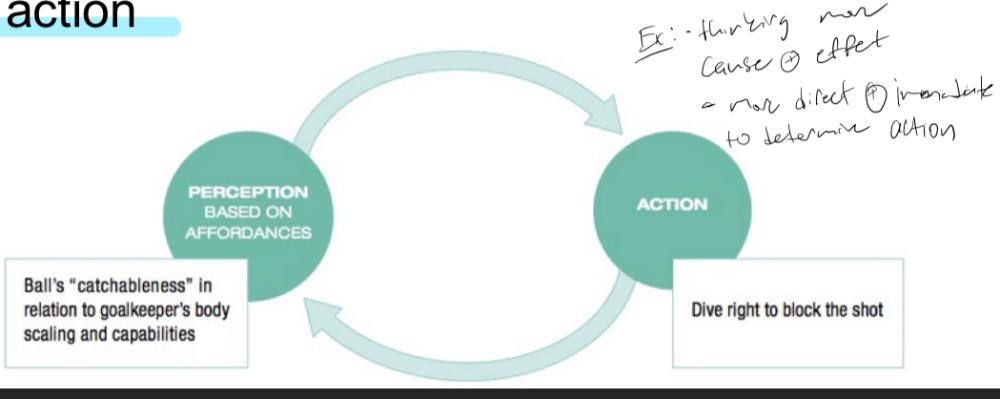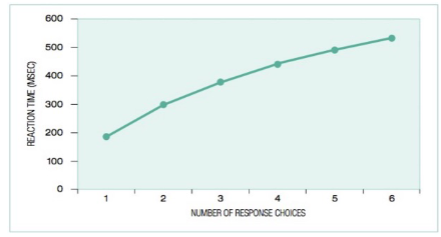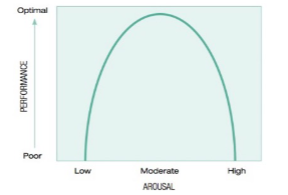Information processing model

- Perception
- Perception leads to action
- Feedback influences perception
Information processing model
Perception
- Meaning attached to sensory
- Information thru mental
processes
- After info received the input
Information processing model
Perception leads to action
- Person + object physical characteristics
- Size of person = strength of person
- Environment
- Rainy = slippery ball
- Emotion + memory
- Remember time you blocked
Information processing mode
Feedback influences perception
- Info from coach on perception
- Organize and execute selected response

Ecological approach
- Affordances
- Relationship
Ecological approach
Affordances
- Action possibilities of the environment and task
- In relation to own abilities
- Directly perceived
Ecological approach
Direct relationship between perception and action
- Cause and effect
- More direct + immediate to determine action
Movement time
- interval between initiation of movement and completed response
- time btn start and end of movement
response time

- interval/time between stimulus being presented and completed (of movement)
- COMBO OF BOTH = reaction time and movement time
Reaction time
- time between presentation/show/appearance of stimulus and initiation/start of response
- depends on processing demand of situation
factors influencing reaction time
- number of response stimulus
- anticipation
- foreperiod consistancy
- psychological refractory period
- stimulus-response compatibility
Reaction time and incertainty

- good to lower uncertainty
- Hick's law
- Low
reaction time + Low stimulus
- sprinter (just sprint off block at gunshot)
- High reaction time + High
stimulus
- shortstop (throw at bases, players, time)
Reaction time
Anticipation
- depends on performer's ability to predict or detect precues
- EX: PT decide when to help in a balance exercise
- situation, opponent, environment, etc.
- can be
learned through practice and study
- EX: teams watch tape of opponents
Reaction time
Foreperiod consistency
- time between warning signal (set command) and stimulus
- "set" command, ball toss in a server. etc.
- allows for temporal anticipation
- when the event will occur
Reaction time
psychological refractory period
- delay in response due to a "fake"
- response delay // neds to react quicker = affects anticipation
- can be decreased with practice
Reaction time
stimulus-response compatibility
- how a stimulus and the required response are naturally related
(RELATIONSHIP)
- EX: car back up with trailer (turning w/ wheel is different)
- EX: aerobics class (instructor mirrors you)
- can be improved with practice
- MIRRORING
- HIGH compatibility of stimulus-response choice
- LOW response delays, LOW wrong mvt, help people preform correctly
Attention
limited attentional capacity
- only so many tasks can be completed successfully at the same time
- not pay attention = HIGH distractions
- GOOD/BAD to multitask
Attention
Environmental and task complexity
- simple to complex
- EXAMPLES
- home vs. work
- @ clinic => have music on? // open layout? // # of clients at a time
- closed => open environment
Attention
skill level of performer
- one skill or compnent of a skill at a time
- with little kids // LOW learning skill // new environment
- ensure they can do the first task BEFORE adding more tasks
Attention
Number of cues
- small at first (Small => large)
- give 1-2 things to
concentrate on
- the less words = the better
- EX: lean forward // knees over toes
Attention
selective attention
- the ability to focus on one thing when exposed to a large
variety of stimulus
- "cocktail phenomenon"
- GOOD/BAD
- help people to what to attend to
Attention
attentional focus
-
WIDTH: amount of information, size of perceptual
field (broad vs. narrow)
- Broad (soccer player on the field) // Narrow (trying to hit a softball)
-
DIRECTION
- Internal: thoughts, specific body movements, etc.
- External: environment, opponent, movement effects, etc.
Attention focus

- broad external
- broad internal
- narrow external
- narrow internal
Practical Implications
- focus will dynamically change depending upon the environment and task
- focused attention will enable one to disregard irrelevant information
-
coaches can inadvertently p[lace negative focus in
an athlete's mins
- "Don't miss the pitch"
- Instruction should be externally focused,
directed at the effects of movements
- "Imagine you are..." // EX: sit and stand
Arousal

- the general physiological and psychological state of activation
- optimal level for arousal depends on task and performer characteristics
- High arousal = powerlifting / shotput (don't think about movement) (LOW attention demands)
Arousal and Movement
Arousal levels influence attentional focus
- LOW arousal => broad attentional focus
- HIGH arousal => narrow attentional focus
- OPTIMAL arousal -> zone of optional function